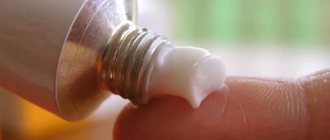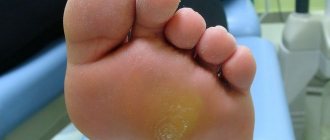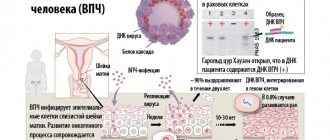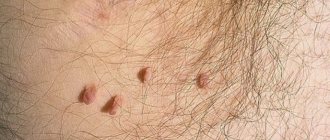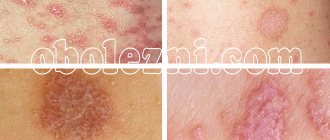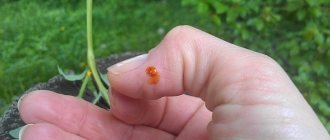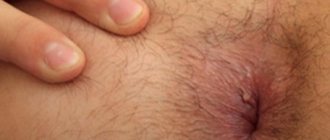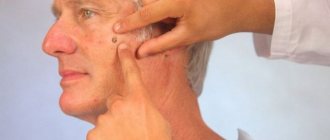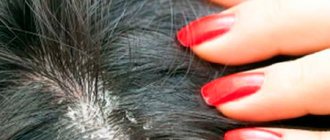Home / Papillomas
Papillomavirus enters the human body in different ways and often leads to the formation of rashes on various parts of the body.
One of its manifestations is considered to be papilloma on the foot, which is a benign, round-shaped formation growing deep into the skin. It is a fairly common problem that causes a lot of inconvenience when walking and often requires long-term treatment.
Etiological factors and developmental processes
The human papillomavirus is extremely widespread throughout the globe and is present in the body of many people. Often manifested by the formation of common warts or papillomas in the foot area. The main reasons for their occurrence are still being studied. But it has long been proven that they are all viral in nature.
Predisposing factors are considered:
- increased sweating of the feet;
- frequent wearing of uncomfortable and tight shoes;
- weakness of the immune system;
- prolonged stress;
- neglect of personal hygiene rules.
The virus penetration pattern is quite simple: any microtrauma on the skin in the foot area is the site of entry of the virus, which quickly spreads throughout the body and is integrated into the genome of skin cells. Ultimately, this leads to the appearance of pathological cells in the epidermis, which are somewhat reminiscent of tumor cells. Over time, the site of infection expands and leads to further spread of the infection.
Important! Often, infection with the papilloma virus occurs in childhood, when the immune system is not yet fully formed, and the occurrence of injuries is a completely natural process. In addition, personal hygiene rules are often not observed or violated by children and adolescents. And in a kindergarten or school, transmission of infection from child to child does not pose any problems.
With age, the problem that arises is eliminated by a strong immune system. That is why formations in the form of papillomas in adults appear somewhat less frequently and are often associated with immune problems.
Frequent colds, exacerbations of chronic diseases, long-term hormonal or antibacterial therapy contribute to the occurrence of infection. Sometimes a person may be sick for a long time before the first growths are discovered on the right or left foot.
With the exclusion of provoking factors, the functioning of the immune system gradually normalizes and it is completely restored. In this case, self-healing often occurs when the problem disappears on its own. According to statistics, about 90% of all patients can do without therapy. Basically, the process of self-healing takes from 2 weeks to 2 years and directly depends on the stage of the disease. All this time the person is a carrier of the infection.
Why do papillomas occur on the heel?
The content of the article
Warts or papillomas on the skin are not only unpleasant in appearance, but also cause great discomfort to people, both physical and emotional. Especially if they appear on the heel of the foot.
Such a neoplasm hinders movement, causes pain, and all this leads to increased fatigue, in some cases even causing depression. What to do if a wart appears on the heel? What methods exist to combat the disease? This article will help answer these questions.
A benign epithelial tumor on the heel is formed under the influence of the corresponding virus. There are about 100 strains of HPV, each of which has a predilection for a specific part of the body. Papillomas on the heels are caused by types - 1, 2, 4, 27, 57. These strains are non-oncogenic, that is, the risk of degeneration of benign tumors into malignant ones is quite low.
Growths appear on the heels a few months after infection. At this time, the person is a carrier of the virus and can infect others. The process of transmission of the pathogen from a patient to a healthy one occurs in various ways - sexual, contact and household. The virus easily penetrates the layers of the epidermis through cuts, injuries, and microcracks.
It is believed that papillomas on the heels and other parts of the body appear most often in older people. However, this is not true, since you can become infected with HPV at any age, especially since the virus is very common in the world. In older people and children, the pathogen manifests itself more often, since this category of patients often has reduced immunity, and this is a concomitant factor for the development of papillomatosis.
In the photo there are papillomas on the heels
The following factors can also provoke the appearance of papillomas on the heels:
- Too dry skin in the foot area;
- High level of foot sweating;
- Violation of the rules of personal hygiene and foot care;
- Various ailments that provoke circulatory pathologies in the legs - diabetes, varicose veins;
- Inconvenient shoes - tight, made of low-quality synthetic materials;
- Various foot injuries - cracks, calluses, injuries;
- Flat feet, arthritis, arthrosis.
As a rule, activation of the papilloma virus on the heel occurs with a general decrease in immunity, as well as after prolonged use of antibiotics, after severe stress, infectious diseases, or due to hypothermia.
Manifestations and symptoms
Externally, papilloma on the foot is a round, dense formation that most often affects the plantar surface of the foot. Its main manifestation is pain while walking, which causes significant discomfort and interferes with full movement. An accompanying symptom is a feeling of itching, the cause of which is most often the growth of the formation and its increase in size.
The favorite localization of plantar warts are areas of close contact and the greatest pressure: feet, heels and fingers. It is in these places that trauma most often occurs and the appearance of microtraumas and cracks through which the papillomavirus can penetrate. Over time, it multiplies and leads to the formation of characteristic rashes. In more rare cases, papilloma occurs on the heel.
Gradually, some roughness forms on the surface of the papillomas. In its center, black dots often form, which are the result of blockage of the feeding blood vessels in the thickness of the growth. And along the edges a characteristic ridge of dead skin cells forms. Externally, the growth looks like a small elevation above the surface of the skin. It rarely grows more than 1 or 2 mm in height. This is explained by the fact that it grows inside the epithelium, pushing apart the surrounding healthy tissue.
This characteristic structure is not the only feature of papilloma. It often happens that new ones form near the first wart, which are called daughter warts. Over time, they begin to merge and form a very massive formation, which can cause quite severe pain. Most people can turn to specialists at this stage, when moving normally becomes especially difficult.
Complications
While walking, the foot is subject to mechanical stress. This is what leads to complications associated with frequent injury and irritation of the skin.
Lack of treatment may well cause infection and tissue necrosis. Oncogenic papillomas under conditions of constant irritation are prone to malignancy - the process of malignancy or degeneration into cancer.
Signs of the initial stage of skin cancer include dark spots, subcutaneous nodules, flaky surface, and ulcerations.
Diagnostic measures
The final diagnosis for suspected papillomas in the foot area is most often made by a dermatologist, who focuses not only on the patient’s complaints and external pathological signs. Additional research methods come to his aid. General clinical blood tests help identify signs of weakening of the body and manifestations of concomitant diseases.
In a general blood test, the first manifestations of a problem with immunity are noticeable, which is indicated by changes in the leukocyte formula. If necessary, an immunological study can be performed and a consultation with an immunologist can be scheduled. PCR diagnostics allows you to determine the exact strain of the virus and prescribe specific treatment.
Diagnostics
If tumors are detected on the leg, the patient needs to consult a dermatologist. After a physical examination of the papilloma on the legs, the doctor will refer the patient for PCR analysis. The polymerase chain reaction method allows you to determine the presence of the causative agent of the disease. This is the “gold standard” for identifying the causative agent of infection when visiting a dermatologist with suspected HPV.
In addition, the patient may be prescribed an immune status test (test for antibodies to viruses). If, in addition to skin tumors, the clinical picture also includes other symptoms (for example, enlarged lymph nodes), then the doctor may prescribe an additional ultrasound examination.
Various therapy methods
Regarding the effectiveness of therapy for plantar papilloma, much will depend on the timeliness of the start of treatment measures and the general state of the immune system.
It is necessary to solve the problem urgently when papilloma:
- causes discomfort and severe pain;
- interferes with normal movement;
- grows quickly and becomes large in size;
- has subsidiaries;
- begins to change color.
The main rule in the therapeutic treatment of skin tags is to identify their underlying cause. It is necessary to eliminate it and further strengthen the immune system. Options for removing papillomas from the surface of the skin of the foot are quite varied.
- Application of instrumental techniques. It is carried out in medical institutions using laser, electrocoagulation, liquid nitrogen, and radio wave radiation.
- Surgical treatment. It is a priority in cases where there is a deep growth of characteristic formations in the thickness of the skin, and their “root” needs to be excised. During surgery, the growth is excised down to healthy tissue. Often leads to the formation of scars and is the reason for the re-entry of the papillomavirus into the general bloodstream.
- Drug therapy. It is popular because in most cases it has a good effect and can be used at home.
| Medications | |
| Salicylic acid | An affordable and effective drug against papillomas in the form of ointment or drops. Softens the formation on the skin, providing a local irritating effect together with a cauterizing effect. For convenience, manufacturers produce a salicylic patch - “Salipod”, which works well for plantar localization of warts. Requires long-term use. |
| Lapis | Available in the form of special pencils containing silver nitrate. Leads to staining of growths with their gradual removal. For maximum effect, a couple of applications daily is enough. |
| Iodine | A cheap and accessible remedy against papillomas. To obtain a positive effect, application up to 2 times a day is enough. |
| Super clean | It is based on alkali. Apply once directly to papillomas. If there is little or no effect, the procedure can be repeated. |
| Feresol | The basis of the drug is phenol, which has a cauterizing effect. Apply to plantar growths at least 10 times to achieve maximum effect. Helps remove growths in a short time. |
All of these drugs are based on the action of acids or alkalis, which have an effect that causes a chemical burn. Often, a consequence of the use of these drugs is the formation of a scar at the site of the papilloma.
Important! It is recommended that before directly using any product, you carefully read the instructions attached to it. Any treatment is allowed to be used only after consultation with a doctor. He will be able to competently assess all the indications and contraindications for a particular method, as well as take into account the presence of indications and contraindications.
Healthy recipes
Alternative medicine, which has a lot of recipes that are very popular all over the world, helps very well against papillomas in the foot area. They have been tested over years of use and are always relevant. The most important thing here is not to overdo it, since any product used can lead to burns of the skin on the leg.
To remove papillomas in the foot area, you can use the following home recipes from traditional medicine:
- Juice of fresh milkweed or celandine. It is used for any localization of papillomas and has an excellent effect. You can burn off the growth with the juice that is released when the plant is cut or picked. Application 2 or 3 times a day for several weeks is usually sufficient.
- Vinegar. It is very popular because it is easily accessible and is often stored right in the refrigerator at home. You only need to apply a couple of drops to the growth to get a good healing effect. You can also apply a cotton swab soaked in vinegar to the papillomas, and then secure it with a band-aid. It is recommended to keep this bandage for no more than 12 hours. To soften, you can add flour to the vinegar to obtain a dough from which you can make small cakes. They need to be applied to the papillomas and secured with a bandage or plaster. The growths should disappear in a few days.
- Garlic. Even half a garlic clove can be very effective against plantar papillomas. You can lubricate the growth with it or attach it to it with a plaster. Or simply grind it until you get a homogeneous paste and make a compress with it for several hours. You can crush the cloves and pour vodka, then put them in a cool, dark place for a couple of days. To use, you need to soak a cotton or gauze swab with the prepared tincture and attach it to the formation on the surface of the skin overnight.
Before directly using any recipe, it is useful to make a foot bath. You need to steam the papillomas in it for 15 minutes. After such a thermal procedure, the surface of the papilloma will take on the appearance of a so-called “terry towel.” This will allow any product to better “impregnate” it to provide maximum therapeutic effect. And to protect healthy tissue, a plaster that needs to be stuck around the papilloma is suitable. You can also use any baby cream that should be applied to healthy skin.
Adjuvant therapy
Every person who is faced with the problem of the formation of papillomas on the surface of the feet should understand that the methods and methods of treatment listed above only help get rid of the external manifestations of the disease. Its main cause, the human papillomavirus, is not going away. And its active reproduction will, over time, again lead to the appearance of characteristic growths.
Ancillary therapy, which consists of prescribing anti-inflammatory drugs, helps to bring the virus under control. The reproduction of papillomavirus is well suppressed by Inosine pranobex, which has an antiviral and immunomodulatory effect. Sometimes drugs from the group of cytostatics, interferon therapy (Viferon) and external therapy (Panavir, Imiquimod) are prescribed. Zinc sulfate is also effective against growths in the foot area.
Treatment of papillomas is a rather labor-intensive process. Especially at home, since it is difficult to remove growths that are located deep in the skin and constantly grow. Therefore, sometimes you have to be very patient and spend a lot of time until the problem completely disappears. Papilloma in the foot area can occur in anyone who likes to go to the pool without slippers, neglects personal hygiene, often injures their feet and has a weak immune system.
The reason for this problem lies in human papillomavirus infection, which penetrates the human body in various ways and, in the absence of strong immunity, actively multiplies. There are not many people all over the world who have not encountered this infection, so no one is immune from the formation of papillomas on the sole of the foot. But with timely seeking medical help and the right choice of treatment, you can get rid of this unpleasant problem forever.
The papilloma virus can appear in any person.
This infection can remain in the human body for years, and may manifest itself quite unexpectedly, at an inconvenient moment for the person.
How to deal with this problem?
Which remedies are most effective?
In this article we will look at the causes and symptoms of the disease.
Folk remedies for warts on the foot
Folk remedies can also be effective in treating papillomas. We have collected the most common folk remedies:
- Dry cotton wool and egg. Apply dry cotton wool to the papilloma and fix it with adhesive tape. We wear cotton wool for 2-3 weeks, changing it after water procedures. Over time, the papilloma begins to dry out and fall off. In the initial stages of HPV manifestation, egg white can be used. To do this, you need to crack the egg, break it, pour out the contents, and spread the remaining white from the shell on the papilloma.
- Celandine. Grind fresh celandine, squeeze out the juice, evaporate until the extract becomes thick. Apply the resulting product to lubricate the papillomas on the leg until they disappear. You can also lubricate the growths with the extract 3-4 times for 2 minutes. The procedure lasts 2-3 days, allowing you to achieve maximum results in a short time.
- Ointment on walnuts. Green walnuts must be cut into slices and passed through a meat grinder. Place the ground nuts in a liter glass jar, filling the latter 2/3 full. Next, pour purified kerosene into the jar, close it tightly, and let it brew in a dark place for 3 weeks. Apply the resulting product to lubricate papillomas 1-2 times a day.
- Potato juice. We wash the red potatoes with a brush, cut out the eyes, grate them on a fine grater, and squeeze the pulp through several layers of gauze. We take the product 2 times a day, half a glass, or a glass 30 minutes before meals. The course of treatment lasts about 2 months.
- Honey with celandine. At night we spread honey on the papillomas on the leg and wash it in the morning. Squeeze the juice out of the celandine, dilute it with saliva, rub it into the skin growth, and fix it with a band-aid. The procedure is effective, the growths dry out after 2 days.
As you can see, traditional medicine provides many effective treatment methods at home, some methods do not even cause the inflammatory process to appear. But so that papillomas on the leg and HPV no longer bother a person, it is worth consulting a doctor, who will help you choose treatment to suppress the virus and its manifestations.
Different types of treatment for the virus
The treatment of papillomas should only be prescribed by a specialist doctor.
Therefore, you should not trust the treatment of papillomas to beauty salons and people without medical education.
It is very important not only to remove papilloma on the human body, but also to get rid of the infection in the body.
This can only be done with the help of complex therapy.
Surgical intervention
Perhaps the most effective and common way to combat the human papillomavirus is surgery.
Surgeons cut off the tumor with a scalpel under local anesthesia.
The second surgical method is radiosurgery.
In this case, the papilloma is removed using a radio wave scalpel.
Medication methods
If you discover a tumor on your foot, you should immediately consult a doctor.
Only a doctor can identify the cause of the formation and prescribe the correct course of treatment.
Most often, if the infection has not become acute, doctors prescribe topical medications such as ointments and creams.
The Russian pharmaceutical market offers a lot of ointments and creams against the human papillomavirus.
The most effective and affordable drugs are:
- oxolinic ointment;
- salicylic ointment;
- Viferon ointment.
All these remedies are very effective in helping with human papillomavirus.
The ointment is applied in a thin layer to the neoplasm and sealed with an adhesive plaster. Every six to seven hours the ointment is reapplied.
Salicylic ointment is very popular due to its low cost in the domestic pharmaceutical market. The average cost of ointment in pharmacies is 37 rubles. To treat the skin, a 60 percent ointment solution is used. The only disadvantage of this drug is the severe burning pain when applied to the skin.
Oxolinic ointment is also very effective in fighting papilloma infection. The cost of Oxolinic ointment is 70 rubles.
Doctors say that to completely get rid of papilloma, complex therapy is necessary. This can be achieved with the help of immunostimulating and antiviral drugs. The difference between these drugs is that immunostimulants affect the human immune system, giving it a chance to independently fight the virus. Antiviral drugs act on the virus itself.
For HPV, it is permissible to use the following drugs:
Isoprinosine is a very effective immunostimulating drug.
This product is available in tablet form. Isoprinosine blocks viral enzymes in the body, thereby suppressing the spread of infection.
The cost of this drug is 127 rubles. Likopid is also an immunostimulating drug. This drug is available in the form of 10 milligram tablets.
A significant disadvantage of this product is its price - 630 rubles.
Reasons or reasonA?
The only reason is the human papillomavirus, abbreviated as HPV - read all about this virus. ATTENTION: parasites in the intestines do not cause warts! (see disclosure from Elena Malysheva).
Infection scheme: a person scratches the skin. The virus penetrates the skin. It is integrated into the genes of skin cells. And the cell takes on ugly shapes, becoming similar to tumor cells. Many of these cells look like warts.
Attention: some types of human papillomavirus can cause cervical dysplasia and cancer (read a detailed article about cervical dysplasia).
Got infected! When did this happen?
Infection with the type of HPV that causes warts occurs during childhood. Almost all children become infected with this virus - in kindergartens, schools, and public places. But not everyone gets sick - it all depends on the immune system.
Warts appear for the first time in childhood. Then the adult’s immune system copes with this virus. Therefore, warts on the skin rarely appear in adults. And if an adult has spines, this indicates a decrease in the activity of the immune system. Read more about the functioning of the immune system.
The entry points for the virus are injuries to the soles of the feet and palms: scratches, cuts, abrasions and calluses.
Provoking factors are excessive sweating of the feet and wearing tight shoes, stress.
Etiology
It is worth taking into account that if the mother is infected with the virus, the latter can be transmitted to the newborn baby.
It is also noteworthy that the virus may not show any symptoms for a long time. The incubation period lasts from several months to several years.
Symptoms and manifestations
The main manifestation: a dense round formation on the palm or sole of the foot.
The main symptom: pain when walking and itching in the area of the wart.
- a small “callus” appears on the skin,
- she's a little itchy
- slight pain when walking.
In 2-4 weeks
- a rough surface appears in the center,
- often – black dots in the center,
- along the edges there is a small roll of keratinized skin.
- Why do spines appear on the palm and sole? Because the skin here is especially dense (unlike other parts of the body). And this type of HPV virus affects just such skin.
- Why does it hurt when walking? Because a plantar wart grows inward. When walking, the weight of the body presses on the wart and it compresses the pain receptors.
- Why is itchy skin? Because the ugly cells grow and put pressure on nearby skin receptors, which leads to itching.
- Why black dots? This is the result of blockage of blood vessels in the thickness of the wart on the foot or palm.
Dimensions – 3 -10 mm. In this case, the pathological formation rises above the surface of the skin by only 1-2 mm, because it grows inward and in breadth.
Daughter warts may appear nearby. They merge with the mother and form a painful conglomerate. This is a clear indicator of decreased immunity. And this often requires drug treatment.
Yellow is the surface of the skin. Violet – cells affected by the virus grow, forming the body of the spine.
Treatment in hospital and at home
In 90% of people, a wart on the foot or palm goes away without treatment at an early stage, and in 30% of cases - in the first 3 months. The immune system suppresses the virus and heals the skin. The time of self-healing depends on the stage of the process: from 2 weeks to 1.5 years.
When should a spine be treated?
When the body itself cannot cope with the disease and needs help:
- if it hurts a lot,
- if it interferes with walking,
- if it has grown to a large size,
- if subsidiaries appear nearby.
How and with what to treat?
Removal is a treatment method that is successful in 98% of patients.
1) Removal with drugs
For these purposes, locally necrotizing agents are used.
- Solcoderm (detailed article about this drug - link),
- Vartox (read in more detail - link),
- duofilm (instructions),
- Collomak (instructions),
- super clean,
- verrucacid, or feresol (read instructions) - acts more gently, has good effectiveness,
- lapis (read about lapis pencil) – effective with long-term use.
They contain acids or alkalis. Removal of plantar warts (spikes) occurs through a chemical burn of the skin. The wart dies. And in this place there remains an inconspicuous scar.
Traditional methods - can I start with them?
Non-traditional treatment methods are ineffective. For a quick cure, dermatologists recommend removal.
Garlic kills viruses.
- The wart is steamed in hot water and partially cut off with nail scissors. At the same time, the skin ridge is cut off. The wart tissue itself is partially cut off. If the wart's vessels bleed, it's not scary.
- Cut the plastic off the garlic and place it on the wart.
- Attach with adhesive tape.
Leave it like this overnight. We repeat in the morning. If you don’t want to “smell” garlic at work, postpone the procedure until the evening.
And so every day for a week or two.
The wart goes away in 3-4 weeks.
2) Treatment with fresh celandine juice (herb)
Celandine juice kills viruses.
Lubricate the spike with fresh orange celandine juice 4-6 times a day. You can trim it a little.
The wart goes away in 1-2 months.
3) Varnish and tape method
This method was suggested by a site reader: link
4) Method with BF6 glue (reader reviews)
5) Method with dry potassium permanganate (reviews and recipes from readers)
Prevention is the foundation
- Wearing loose shoes.
- Treatment of excessive sweating of the feet.
- Treatment of foot injuries, scrapes and cuts.
- A healthy lifestyle and strengthening the immune system is the prevention of viral diseases, including the HPV virus. Detailed material about how to strengthen your immune system is here
I also recommend reading these materials:
Attention: if the doctor did not answer your question, then the answer is already on the pages of the site. Use the search on the site.
